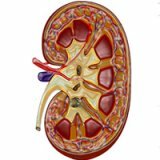Urine nephropathy in children

Urine nephropathy in children is a kidney damage that can be caused by direct exposure to uric acid crystals. There are three variants of nephropathy in children. The first option includes obstructive tubular tubulointerstitial nephritis, chronic tubulointerstitial nephritis and procedural urate nephrolithiasis. Often, there can be a combination of all three variants of kidney damage that can lead to the development of atomic nephrosclerosis.
Against the background of urolithiasis secondary pyelonephritis also develops. The manifestation of symptoms of this disease includes an increase in temperature, dysuria, bacteriuria, leukocyturia. With increased filtration and the development of uropaths with gout, deposition may occur in the medulla in the kidneys or in the cortical layer.
Immune glomerulonephritis also occurs, which proceeds according to the type of chronic concealed nephritis, etiologically it is associated with a violation of purine metabolism.
Secondary disorders in the appearance of urate nephropathy in purine metabolism constitute a group of phenomena that arise in pathological conditions. These include diseases of myeloproliferative and hemolytic anemia, berylliosis, sarcoidosis, hypoparathyroidism, hyperthyroidism, hypothyroidism, Bartter's syndrome, psoriasis and others. Great importance is attached to such anthropogenic factors as the effects of cadmium, lead, the use of diuretics, salicylates and other drugs.
Clinical picture of urate nephropathy
For tubulointerstitial urate jade, the appearance of severe urinary syndrome in combination with microhematuria is characteristic. In addition, there is a violation in the concentration function of the kidneys and hypertension. In the early stage of the disease, there is increased renal excretion, which is accompanied by an abundant urination in normouricemia and hyperuricemia. It is also possible to develop urate nephropathy in an isolated combination with characteristic arthritis of the gout. When the kidneys are affected, the latent flow can alternate with the acute tubular process of obstruction.
Diagnosis of urate nephropathy
Often urate nephrolithiasis occurs in children in a latent form, it is detected accidentally when examining the kidneys through ultrasound. Often urate neuropathy is diagnosed in stages with slowly progressing azotemia expressed by AH.
Treatment of urate nephropathy
If urate nephropathy is found in children, the pathology that caused abnormalities in purine metabolism, the child is examined for uricemia or uricosuria. If the normal value of at least one of all parameters is exceeded, then a low-purine content diet can be used, it is also necessary to provide a sufficiently high urine output by using liquid diets and applying a weak tea with lemon or milk. It is also necessary to exclude general overheating and heavy muscular work for the child. With this is associated with the use of heavy portfolios in school, so you should reduce the burden on the time of treatment.
Detection of AH requires daily monitoring of blood pressure. In addition, the use of dietary and medicinal correction is applicable. If signs of crystallization of urate in the bladder, the formation of urate stones in the kidney in a child, then the formation of hypertension should discuss the further treatment of children with the use of drug correction to prevent violations of purine metabolism. In this case, the drugs are selected taking into account the features of the course of the disease, in particular, the ACE inhibitor. In the early stages of urinary nephropathy in children, the phenomenon of hyperuricosuria may occur, which requires treatment with the appointment of allopurinol. If later stages are observed with hyperuricemia, in addition to allopurinol, benzobromarone preparations and combinations of drugs such as allomaron can also be prescribed.



